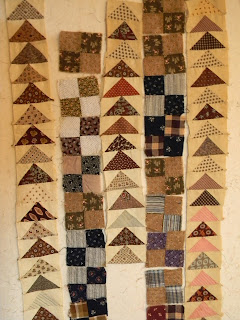In the 1980's Amish doll quilts and dolls were very popular and I purchased a pattern and made the set. Now for those of you not versed on these dolls, they have no facial features or hair. The Amish custom is possibly linked to the second commandment (Exodus 20:4-6) in regards to not having images, likenesses, or idols. Just like the pattern I made this doll with a black bonnet and a solid blue dress.
The first thing my daughter did when she saw the doll was take it and draw a face in crayon on the head. I found it later in her closet. I was not a student of children's cognitive development and their ability to understand the concept of reflections of themselves, mirrors, Amish traditions, etc. My daughter was more eloquent in her explanation and rationalization of dolls having faces because people have faces.
Fast forward 10 or so years and my youngest daughter is in my sewing room keeping occupied quite nicely......................until I needed to do some ironing and noticed my pressing ham. I look back in retrospect and I am not proud of myself when I had a bit of a meltdown about the ink marks and how I might never be able to use the ham again....... but there it was in all its glory smiling at me. It was the Amish doll incident all over again!!
And now, you might ask why I would bother to tell you about this little snippet of the past. Well, it is a fact that to this day, I am never without my friend in my sewing room. This little face has brought me more pleasure over the years because it reminds me of my kids. I'll share my ham with you now:
 |
| How can one not smile at such an infectious grin from this character? What a ham!! |


















































